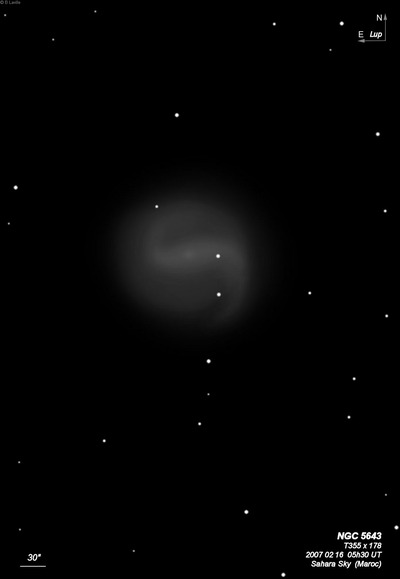
James Dunlop probably discovered NGC 5643 = D 469 = h3572 on 1 Jun 1834 and recorded "an exceedingly faint, extended nebula, about 10' long; rather ill-defined." His position is 7' due east of the galaxy. John Herschel first observed the galaxy on 1 Jun 1834 and logged "pB, L, vgbM, 2', resolvable, or with stars." Two nights later he noted "pF, L, R, vglbM; has many stars intermixed."
300/350mm - 13.1" (4/10/86): faint, diffuse, fairly small. Two stars are superimposed on the south and SW side.
400/500mm - 18" (7/5/05 - Magellan Observatory, Australia): fascinating glimpses of structure at 228x! This galaxy was fairly bright and large, round, ~3.5' diameter. The surface brightness was clearly patchy in the halo due to the strong impression of clockwise spiral structure but there was only a broad, weak concentration in the center, except for a sharply concentrated, bright 15" nucleus. A broad spiral arm is attached on the east side of the galaxy and shoots sharply to the north. There was an impression of another spiral arm attached on the west side of the galaxy. It appeared to sweep towards the south in a clockwise orientation, though this structure was not as well defined. A string of five stars angling SSE to NNW appear to puncture the galaxy on the south side with the northern two stars superimposed on the west side of the galaxy. The last star in the chain is just west of the nucleus. Located in a star field densely peppered with stars.
600/800mm - 24" (4/11/08 - Magellan Observatory, Australia): at 260x I was very impressed with this large, bright barred spiral. The halo is slightly elongated, ~3.5'x3.0' and sharply concentrated with a very bright, small, core. A brighter bar oriented E-W extends through the center. A star is superimposed on this bar to the west of the core. A second superimposed star lies 35" to the south and continuing on this line is a third star just at the edge of the halo, 1.7' S of center. At the east end of the bar a slightly enhanced arc sweeps clockwise to the north and a similar enhancement on the west side sweeps to the south. The faint arc or arms wrap around 180° making a complete outer ring. The central bar and the outer ring together formed the Greek letter "Theta". NGC 5643 is situated in a fairly rich Lupus star field.
Notes by Steve Gottlieb